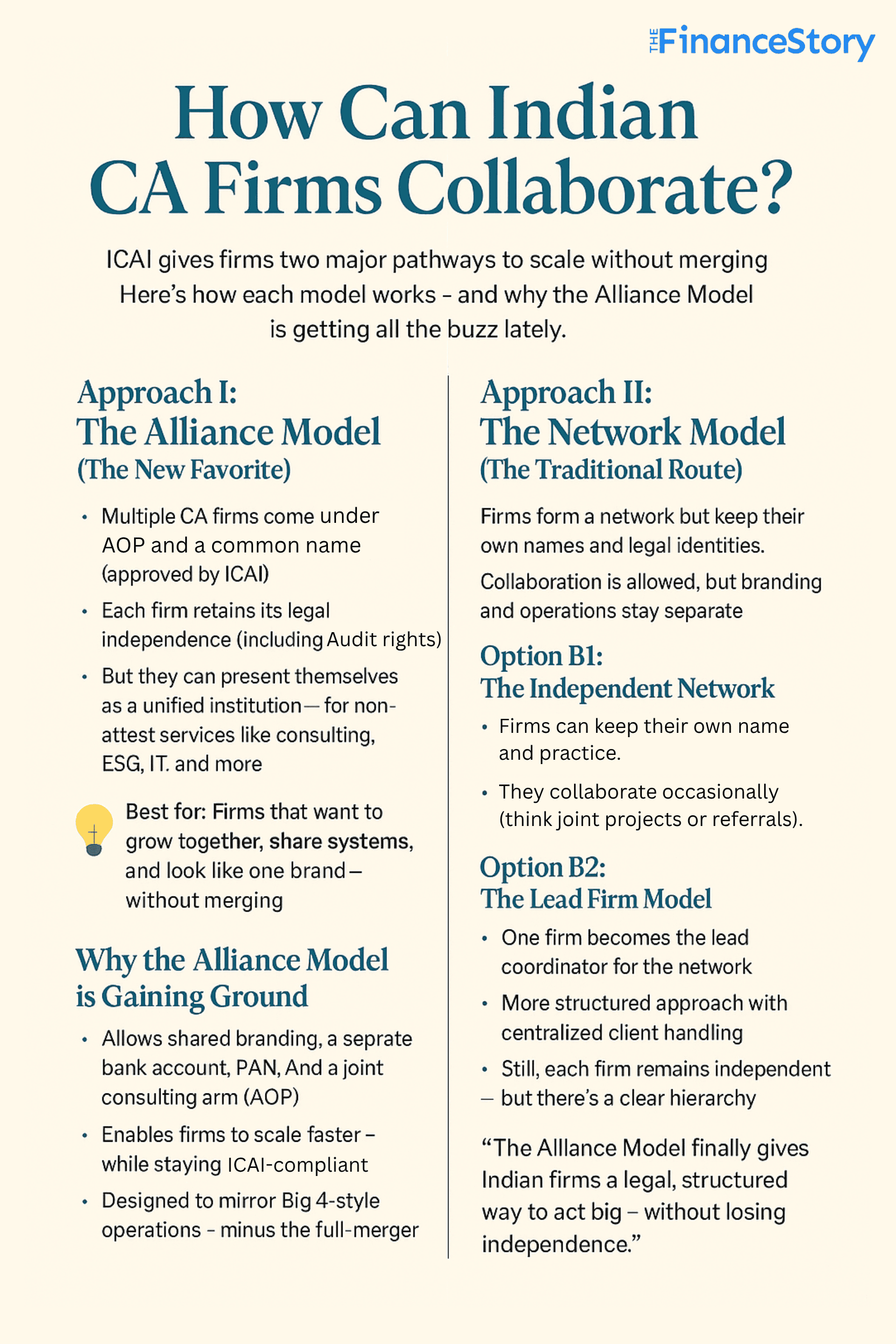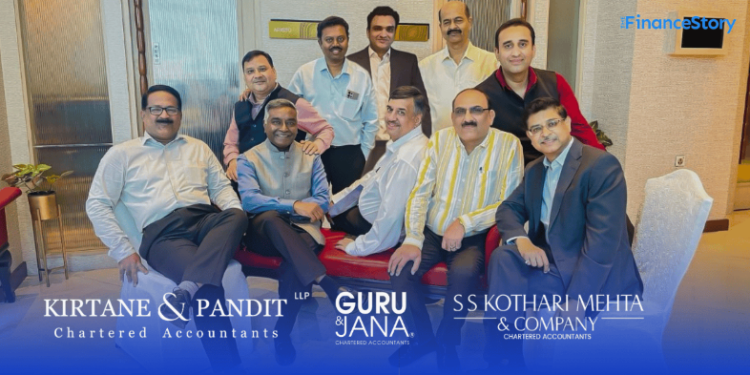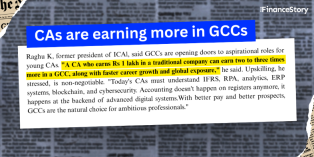- On July 1, 2025, three homegrown Indian CA firms—Kirtane & Pandit, Guru & Jana, and SS Kothari Mehta & Co.—did something HUGE.
- No, they didn’t merge.
- They unleashed the ICAI Alliance Model, which was introduced in 2021 but went unnoticed!
- Yes — the ICAI Alliance Model can absolutely let Indian CA firms go global and compete with larger / Big 4 firms, all while staying truly Indian.
- Here is how the 3 firms came together and made it happen.
Back in 2005…
The Institute of Chartered Accountants of India (ICAI) introduced Networking Guidelines – an ambitious plan to help Indian accounting firms scale.
But adoption remained disappointingly low!
In nearly twenty years, very few networks were formed, and none achieved any significant scale.
That changed in 2021…When ICAI revised the Alliance Model, a bold framework.
Still, most firms overlooked it until July 1, 2025, when three prominent CA firms finally joined forces under the ICAI’s “Alliance Model”

Meet the Firms behind the Alliance
Kirtane & Pandit: Headquartered in Pune and established over 70 years ago, Kirtane & Pandit ranks among India’s top 15 homegrown mid-sized firms.
Today, it has:
- 1,200+ professionals
- 40+ partners
- 11 offices across the country
S S Kothari Mehta & Co: Founded in 1953 in Kolkata and now headquartered in Delhi, SS Kothari Mehta & Co. is a well-known national firm with:
- More than 20 partners
- Over 500 employees
- A legacy of serving listed companies, multinationals, and government organisations across diverse sectors
Guru & Jana: A Bangalore-based, first-generation firm with a reputation for innovation, Guru & Jana has:
- A team of over 700 professionals
- Offices in multiple locations across India
So, what exactly is the ICAI Alliance Model?
At its core, the ICAI Alliance Model lets “multiple CA firms” come together under a common identity, legally recognised as an AOP (Association of Persons).
So essentially,
- AOP has its own name, PAN, and even a bank account (This was not possible in the network model)
- An AOP cannot perform audit or attest functions – Those continue to stay with the individual CA firms registered with ICAI.
- But the non-attest work, the consulting, the strategy, the tech, can move to the alliance arm.
By forming an Alliance and creating an AOP, firms can:
- Build scale “without merging” their entire businesses
- Present a unified front under one brand
- Unlike networks, the alliance can legally market and present itself as a single entity. (This was sooo needed!)
- Firms can combine their balance sheets, profiles, websites, and policies under one umbrella.
- Combine their profiles and pitch together for larger mandates
This marked a BIG distinct shift from the Networking Model.
Also read: Desi Big 4s: Government & ICAI revamp rules to build India’s Big 4
But how did all three CA firms come together?
It all started when Sandeep Welling, Managing Partner at Kirtane & Pandit, decided to focus on the ICAI Alliance model.
He spent months driving across the country—from Chennai to Delhi—meeting with 30 to 35 firms to explore the idea of an Alliance.
There were many rejections.
Some firms didn’t share the same vision or weren’t ready to collaborate at scale.
But Kirtane & Pandit, SS Kothari Mehta, and Guru & Jana kept coming back to the table….They kept discussing!
Coincidentally, each one of them wanted to build an India-first firm and had never been party to any of the foreign networks.
Of course, coming together was far from easy….
Each firm had its own legacy clients, partners, and confidential data.
There were serious concerns about:
- Conflicts of interest
- Data confidentiality
- Governance and decision-making
Each of the firms wanted,
- To preserve their independence
- To contribute equally
- And to grow together, without stepping on each other
The intent was always there. What mattered was the clarity of purpose.
All three firms played an active role, from early ideation to structuring the alliance.
It wasn’t driven by just one firm; it was built through months of joint discussions, rigorous governance planning, and alignment of values.
Once that was aligned, everything started to move.
Initially, they targeted a February 2025 launch. But, as often happens, the process matured at its own pace.
Ultimately, they formalised the alliance on July 1—symbolically, CA Day.
Equal contribution. Shared vision. Mutual trust made this possible.
Also read: Indian CA Firms can now tie up with global accounting firms
What next? How will these three firms operate?
Kirtane & Pandit’s Managing Partner told The Finance Story that it’s going to take some time before they finalise a unified approach.
However, the alliance will operate through two parallel arms:
- Member Firms (ICAI-registered): Will continue handling all attestation and audit services independently.
- AOP Entity (Consulting Arm): Will manage non-attestation functions such as ESG advisory, IT consulting, outsourcing, and tax structuring.
Over the next 12–18 months, they plan to implement several common initiatives as part of the Alliance:
- Technology platforms and training programs
- Create an integrated campus recruitment and learning ecosystem
They want clients to experience the same consistency—whether they work with Guru & Jana, K&P, or SSKM. Just like you’d expect from the Big 4.
Are there other Alliances in India?
There are seven ICAI-approved alliances on paper, but most have remained under the radar.
This might be the first truly visible, pan-India alliance with global aspirations.
It’s not about competing with the Big 4….
For decades, Indian CA firms have asked for one thing: the opportunity to compete on equal footing.
Thanks to ICAI and RBI reforms, that opportunity is finally here.
This alliance proves Indian firms don’t need foreign affiliations to scale. They can collaborate, go global, and remain proudly Indian.
The Indian consulting and advisory market stands at $4–4.5 billion, projected to grow to $6 billion in the next few years.
A study estimated India needs 50–60 large firms to meet future demand. Right now, there are too few.
India needs more such strategic alliances. But it won’t happen without letting go of the ‘me’ mentality and embracing a ‘we’ mindset.















Great write up ! Thanks.
Great insights!
Out of the seven ICAI-approved alliances, we are the 1,
S K Y M A P and Alliance registered in 2022. Visit http://www.skymapalliance.in for more details.
Appreciate the write up, but requesting the author to fact check the article thoroughly!
Thanks for the time! This article has been 100% fact-checked and carefully reviewed—just like all our content. If there’s anything you’d like to share or suggest, please feel free!